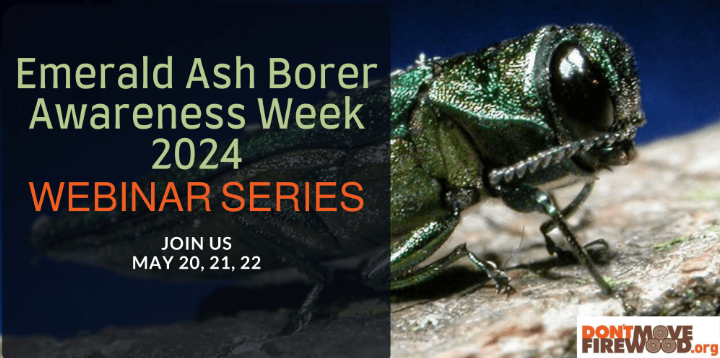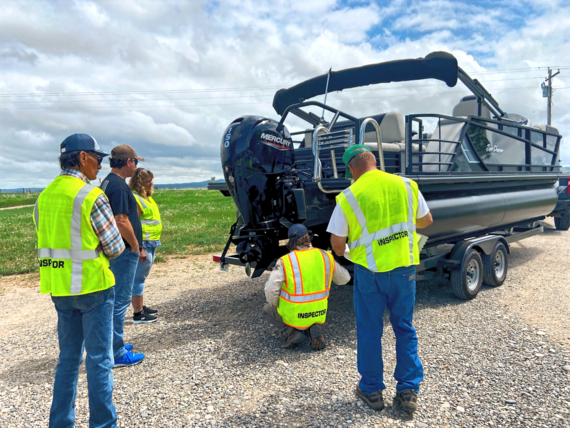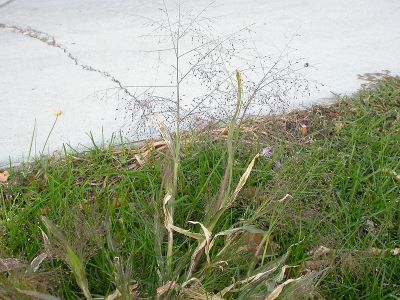Emerald Ash Borer Awareness Week
 Don’t Move Firewood has partnered with Purdue University’s EABU to highlight this notorious tree pest by hosting six emerald ash borer themed webinars May 20-22. Hear from researchers and managers alike over the course of three days. We’ll talk about exciting new developments in ash tree breeding and resistance, research findings on best management strategies, and important updates on management responses to EAB.
Early Detection Rapid Response Webinar
Montana Department of Agriculture will be hosting a Spring 2024 EDRR Webinar, via Zoom, on May 23, from 10 - 11 a.m.

News
Meet the New Insect Killing Utah's Fir Trees
A nonnative tree-killing insect is invading northern Utah, attacking subalpine fir and potentially triggering yet another die-off of the region's long-stressed conifer forests.
Introduced from central Europe into the Pacific Northwest about a century ago, the balsam woolly adelgid, or BWA, first detected in Utah in 2017 and has been spreading around the Wasatch Mountains, visibly affecting many of the popular recreation canyons outside Salt Lake City.
Balsam Woolly Adelgid (Adelges piceae) - Bugwood Photo
New research from the University of Utah, conducted in partnership with the U.S. Forest Service, has documented the current extent of the adelgid infestation and created a model for predicting its severity around the Uinta-Wasatch-Cache National Forest.
USDA Awarded $22.2 Million in Farm Bill Funding to Protect Animal Health
The U.S. Department of Agriculture’s (USDA) Animal and Plant Health Inspection Service (APHIS) is awarding more than $22.2 million to enhance prevention, preparedness, early detection, and rapid response to the most damaging diseases that threaten U.S. livestock.
These 81 new projects led by 48 states, universities, industry organizations, and veterinary diagnostic laboratories will increase our nation’s ability to rapidly respond to and control animal disease outbreaks. USDA is awarding this funding through the 2018 Farm Bill’s National Animal Disease Preparedness and Response Program (NADPRP) and the National Animal Health Laboratory Network (NAHLN). APHIS is also announcing an investment of an additional $900,000 in Farm Bill funds to replenish the national stockpile of classical swine fever vaccine.
“Bolstering animal disease preparedness is crucial because these diseases devastate livestock and hardworking farmers whose animals are affected, and threaten America’s access to safe, healthy, affordable food,” said Jenny Lester Moffitt, Under Secretary for USDA Marking and Regulatory Programs. “APHIS plays an important leadership role in protecting against current and future threats to U.S. animal health, and these investments are key to supporting this work.”
Bighorn AIS Station Opens for Season
 The Bighorn AIS station will open for the 2024 season on Saturday, April 27th. The station, which is funded by Montana Fish, Wildlife and Parks and overseen by the Bighorn Conservation District, is located on the north end of the Big Horn Valley Ranch and is marked with signs and flagging tape. Hours of operation will be Thursday - Sunday from 7:00 AM to 7:00 PM.
Fort Belknap Indian Community Seek Applicant to Update Noxious Weed Management Plan
On behalf of the Fort Belknap Indian Community, the Tribal Land Department would like individuals to update the Noxious Weed Managemen Plan. The Plan expired in 2018 and needs to be updated as soon as possible.
Contract proposals are due May 24, 2024 by 4:30pm.

Witchgrass (Panicum capillare) was very conspicuous across Montana later in the growing season of 2023 and garnered a lot of comments and questions. Witchgrass is an annual warm season grass that is native to most all temperate North America, including Montana. As a C4 warm season grass it germinates later than some other annual grasses in Montana and is most obvious in August and September.
Witchgrass is a native plant that colonizes disturbed areas. In many cases this species does not need to be controlled. However, witchgrass can be weedy in home landscapes, warm season annual crops, and in irrigated crop areas in Montana.
|
Webinars
Montana Noxious Weed Monitoring Toolbox
This innovative toolbox is designed to streamline weed treatment monitoring efforts and is based on the newly established MSU Noxious Weed Monitoring Protocol developed by MSU researchers, Dr. Jane Mangold and Dr. Lisa Rew. This webinar, hosted by the Park County Environmental Council, is an excellent opportunity for coordinators, managers, researchers, and field practitioners interested in:
- Using Survey123 application for weed treatment monitoring and testing accessibility of resources.
- Gaining valuable insights into the MT Noxious Weed Monitoring Toolbox.
- Learning best practices for data collection and management.
Date of Webinar: May 22 at 1:00pm
Alberta Invasive Species on a Global Scale, but Under an Alberta Perspective
According to the latest comprehensive report from the Intergovernmental Platform on Biodiversity and Ecosystem Services (IPBES), human activities have introduced over 37,000 invasive species globally. This staggering number, and its ongoing increase at unprecedented rates, is a cause for concern. Among these, more than 3,500 are deemed harmful invasive species, posing a serious threat to nature, its contributions to people, and overall quality of life.
The Alberta Invasive Species Council will host the webinar 'Invasive Species on a Global Scale, but Under an Alberta Perspective' on June 13th, 2024 at 7PM. Join Nicole Kimmel, Aquatic Invasive Species Specialist with Alberta Environment and Protected Areas and Dr. Patrick Hanington, Associate Professor, University of Alberta as they discuss the latest Intergovernmental Platform on Biodiversity and Ecosystem Services (IPBES) report, the global landscape of invasive species and the potential consequences for Alberta if we relent in our efforts to combat them.
Date of Webinar: June 13 at 7:00pm
Training
AIS Early Detection and Monitoring Workshop
Aquatic Invasive Species Early Detection & Monitoring Training
Research
Native Pathogenic Fungus as a Biocontrol Alternative to Herbicide on Invasive Buckthorns
Common buckthorn (Rhamnus cathartica L.) and glossy buckthorn (Frangula alnus Mill.) are considered invasive plants in North America, capable of displacing native vegetation. Their invasion often results in decreased biodiversity and weakened ecosystem resilience. Therefore, their removal is important for forest restoration. Invasive buckthorns are often managed using chemical herbicides and manual removal. This research sought to determine the efficacy of Chondrostereum purpureum (a naturally occurring basidiomycete in North America) as a biocontrol agent for the treatment of invasive buckthorns in Upper Michigan.
The Lake Dudes Videos
Texas Parks and Wildlife Department uses humor and peer pressure to break through, grab attention and encourage people to not be “that guy” who ruins the fun for everyone at the lake. Check out the "Lake Dudes" videos here!
Save the Date
|